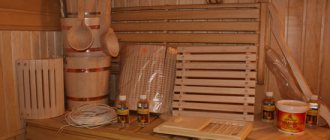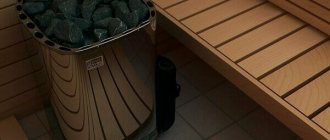For all connoisseurs of bath culture, a bathhouse or sauna is a favorite place to spend time. These steam rooms are very similar, perform the same functions, but there are still some differences between them. So what is the difference between a Finnish sauna and a Russian bath? Let's figure it out.
People who are little familiar with the bathing business believe that a bathhouse and a sauna are practically the same thing. In the steam room you can relax, unwind after a busy week, restore strength after grueling sports training, and even improve your health.
The Finns, like the Slavs, consider the steam room a special place that has a beneficial effect on the entire human body. This is a kind of panacea for most troubles, diseases and misfortunes. But not everyone knows the difference between a Russian bath and a sauna. Although there are several key differences:
- Temperature. The air in the steam sauna heats up to +100°C or more. While in the steam room of the bathhouse the temperature rarely rises above +70°C.
- Humidity. The Russian steam room belongs to the category of steam baths, where the moisture level in the steam room reaches 70-80%. The Finnish sauna is dry air. Here the humidity does not exceed 15%.
- Construction Materials. What else is the difference between a bathhouse and a sauna? A real Slavic steam room is always built of wood. While when arranging a sauna, artificial materials are often used.
- Ventilation. In a sauna, the air pressure inside the room is maintained by external pressure. But a Russian bath is a steam room with excess pressure. In it, steam is formed as a result of the rapid evaporation of water when excess pressure is created in the steam room.
- Broom. True connoisseurs of the classic Russian bathhouse call a broom a mandatory element of a full-fledged bathing ritual. When used skillfully, it provides a unique healing effect. This “massage” evenly distributes heat, increases sweating and improves blood circulation. In the dry air of the sauna, the leaves quickly fall off and the broom itself disintegrates. Therefore, it is not used when steaming in a Finnish sauna.
- Pool. It is a mandatory element of the Finnish sauna. Here, the healing effect is achieved due to a sharp change in temperature - the hot air of the steam room to the cool water of the pool and vice versa.
Classic differences
One of the biggest differences is the steam. A Russian bath involves wet steam, but in a Finnish it is dry. Why is this being done? Steam saturated with moisture allows the use of air at low temperatures. Since humidity reaches almost a maximum, almost no sweat evaporates from the human body. Consequently, the body warms up much more efficiently, and the level of dehydration is almost minimal.
Dry steam will not allow sudden overheating. Since sweating is the main way of cooling the human body, a decrease in its evaporation in high humidity almost completely eliminates the possibility of normal thermoregulation. In saunas this risk is significantly reduced.
What is more expensive
The cost of building a bathhouse or sauna is usually high. The costs, as we found out, will depend on the size of the structure and its layout.
However, building a sauna usually still costs owners of suburban areas a little more than baths. Indeed, in this case, you will have to additionally purchase modern moisture-resistant finishing material for the floor. In addition, electric heaters are, of course, more expensive than conventional stoves. Unlike a bathhouse, you will also have to buy a shower stall for a sauna.
Finnish sauna
Here, due to the use of dry steam, the humidity level is significantly lower - up to 15 percent. As for the sauna effect, it is based on alternating exposure to hot dry steam and cold water. Temperatures can reach up to 110 degrees.
The air pressure in saunas is the same as outside. And the air is dry. It has a low level of thermal conductivity and heats up well over 100 degrees. But this heat is very easily tolerated. In addition to the fact that the difference between a sauna and a Russian bath lies in the principles of operation and the use of different steam, there is also a difference in the design. Let's look at these features.
Sauna and bath: what is the difference
The Russian bath and the Finnish sauna have common features. These are rooms with high temperatures and steam. People come here to relax, improve their health, and restore beauty and youth to their bodies. Often, various diseases are treated with the help of a Russian bath or Finnish sauna. But there is something in which these two places are fundamentally different:
- Temperature and humidity mode in the room.
- Type of oven used.
- Material of manufacture.
- Ventilation design.
But as experienced bath attendants say, the main difference between a Russian bath and a Finnish sauna is the broom. Only in the bathhouse can you enjoy the healing properties of birch, oak or juniper.
Design features: Russian bath
Often the building is located separately. Traditionally, a bathhouse is built from wood, often coniferous. A Russian bathhouse necessarily includes two rooms. This is a steam room and a dressing room, which is both an entrance hall, a locker room, and a relaxation room. All rooms must have a window. It is necessary for better ventilation.
In the dressing room there is a stove-stove, which is heated with wood. The main element that generates heat is stones - hence the name of the stove, which is usually built in the wall between rooms. Its main part, as well as the stones, are in the steam room.
Furnaces can be open or closed. Open solutions are considered more practical, especially when the bathhouse is used for its intended purpose several times a day. This stove warms up the room faster. However, due to frequent watering of stones, it quickly cools down. The stones for these structures are laid above the firebox. The oven can heat up to 300 degrees.
The closed-type device is equipped with a special steam door for better heat transfer. When wood is burned and the door is closed, no smoke enters the steam room. The oven can heat the stones to very serious temperatures. Before visiting the steam room, the door is opened slightly and the room is warmed up. The closed oven must be heated in advance - approximately two to five hours before starting the procedure. Due to the properties of the stones, this design can maintain heat for two days.
The difference between a bathhouse and a sauna lies in the design features, or more precisely in the arrangement of the stones. In the first case, they are placed inside the oven, so they heat up more strongly and cool down very slowly. In a sauna, stones are placed on the surface of the stove.
The main differences between baths and saunas
Arrangement of stones in the furnace
The main and most noticeable feature that allows us to determine the difference between a bathhouse and a sauna is how the stove is designed:
- In a Russian bath, the stones are located inside the stove behind a closed door. By splashing water on the stones, you can maintain the desired microclimate, and a closed space allows you to maintain the temperature much longer.
- The Finnish sauna has a stove with an open heater - the heat goes directly into the room, as a result of which the stones cool down much faster.
Availability of a swimming pool
A traditional sauna always has a swimming pool, while in a Russian bath it is completely optional. This is due to the fact that the maximum effect of sauna procedures is achieved due to the contrast of hot steam and cold water.
After a Russian bath it is also very pleasant to plunge into the water; it is not for nothing that most of these buildings were erected on the banks of rivers and lakes. If there was no body of water nearby, a system with a tub of water and a rope came to the rescue - you pull it, and cold water splashes over you.
A swimming pool is an indispensable attribute of any sauna.
Humidity and temperature indicators
It is this aspect that is fundamental - the differences between a bath and a sauna lie in the effect on the body, and it directly depends on the above factors:
- Wet steam used in a Russian bath provides optimal conditions for staying in the steam room: 55-70 degrees with a relative humidity of 40 to 70%. Humid air conducts heat much better and has a gentler effect on the body.
- The steam in the sauna is heated to a temperature of 100-130 degrees, while the optimal humidity should be in the range from 3 to 8%, sometimes the value can reach up to 25%. High temperatures cause active sweating even at low humidity.
Features of the microclimate
Both the sauna and the bathhouse are primarily designed to remove toxins from the body. This occurs by heating both the skin and the entire body. This is a kind of mild shock for all organs, so it is better if the process takes place under milder conditions.
Due to the lower temperature and almost natural humidity for humans, the Russian bath is much preferable due to less stress on the body. In a sauna, rapid heartbeat and vascular spasm appear much more clearly, and this is undesirable for a number of diseases.
It should be noted that the microclimate in a sauna is much more stable than in a bathhouse, since there the flows of air and steam move much more intensely, which is why it is necessary to constantly maintain the required parameters. In this regard, staying in a sauna is much easier.
Important note: despite the fact that the conditions in the sauna are much closer to natural, it is much easier to be in the sauna due to more intense sweating. But the load on the body is still lower in a traditional Russian bath.
Despite the high temperature, it is easy to breathe in the sauna due to the low air humidity
Broom as an attribute of a steam room
Many experts, when asked how a Russian bath differs from a sauna, will answer with a broom, and they will be absolutely right. It is impossible to imagine a Russian bathhouse without a broom; this is a kind of its symbol and an indispensable attribute.
In addition to excellent massage, a broom helps open pores, increase sweating and remove toxins. Substances found in the leaves have a beneficial effect on the human body. The benefits of a bathhouse when using a broom increase many times over.
It is impossible to use brooms in a sauna - low humidity and high temperature dry out the broom in a matter of seconds.
In the photo - bath procedures are much healthier with a broom
The benefits of steam rooms for the human body
Many people make baths or saunas with their own hands, not caring about maintaining optimal conditions, because in order to achieve the best result, you cannot skimp on materials and equipment - the price of a good steam room will never be low.
But after finishing the work, you will be able to fully enjoy your relaxation in your steam room. At the same time, remember that you should not visit the bathhouse during periods of exacerbation of chronic diseases. Any health problems require attention, so you should consult your doctor about whether you can visit the bathhouse.
At the same time, many doctors also do not know the difference between a sauna and a bathhouse, so it is better to clarify which steam is healthier for you - dry or wet. As you know, if you have diseases of the upper respiratory tract, you can go to the bathhouse, but you cannot go to the sauna.
It is difficult to overestimate the benefits of bath procedures for the human body.
Important! Problems with the cardiovascular system are not prohibited, but they significantly limit your stay in the steam room.
Finnish saunas
The premises for them can be either separate or built-in. The inside of the room is decorated in the same way as in a Russian bathhouse. Coniferous wood is used as materials.
What distinguishes a sauna from a Russian bath is the configuration of the room. Unlike Russian traditions, the sauna has three rooms. There is a steam room, a dressing room, and a shower. As for the steam room, it is smaller in area than in a Russian bathhouse, has no windows, but there is a forced ventilation system. The dressing room is characterized by its large size.
Traditional (wood-burning) and modern electrical solutions are used as a stove. Wood stoves can be of two types. Some are made of special refractory bricks, while others are made entirely of metal. The main elements in them are the heater and the chimney. The metal structure can be with a built-in heater or with a chimney and hearth. Brick kilns are very similar to Russian ones in their design.
In the first case, the stones are laid on top of the furnace and special screens. In the second, they are located in a horizontal chimney, where they heat up. Nowadays, electric ovens are most often used. They have many advantages over traditional wood-burning devices. The electric unit warms up faster, can automatically maintain the required temperature, and does not require the installation of a forced ventilation system or removal of combustion products. An electric oven can be closed or open.
How the bath works
In Russia, a bathhouse at a dacha is usually a one-story free-standing building with a locker room, a bathhouse and a steam room. Sometimes the last two types of premises can be combined into one. In large baths, among other things, relaxation rooms, billiard rooms, etc. are often equipped.
To heat the rooms in Russian baths, stoves of a special design are installed - heaters. At the top of such heating equipment there is a tank for heating water. Such ovens also have a compartment for stones.
Baths are most often heated with wood. But recently, gas stoves have sometimes begun to be installed in such rooms.
In order to make it more convenient to take water procedures and steam in the bathhouse, wooden benches are installed in the bathhouse. The steam room is equipped with a shelf - a bed of boards in 1-3 tiers.
A distinctive feature of the bathhouse, among other things, is its low ceilings. Thus, such buildings are erected so that “light” steam is then formed in them. The floors in the baths are always wooden. Quite often, large fonts are installed next to bathhouses or washrooms.
Ventilation system
An important difference is in ventilation systems. The sauna experience is most optimal when the internal and external pressures are the same. How is a bathhouse different from a sauna? The traditional Russian version operates on the principle of excess pressure.
If there is no pressure difference in the room, then you will not be able to get good steam. Water vapor is formed inside the furnace volume. It turns out to be a small explosion. Then the steam goes into the steam room through the door opening. Some of it is reflected from the walls and sides of the furnace, due to which the excess pressure increases even more. After this, the steam is released outside. Since it is the hottest, it goes up to the ceiling.
How much will construction cost?
It is impossible to say for sure which is better - a Finnish sauna or a Russian bath. The choice in this case depends only on the personal preferences of the owners of the suburban area themselves. Both the bathhouse and the sauna can make life outside the city much more enjoyable. But in our country, of course, they traditionally build ordinary Russian baths. Many people find wet steam more enjoyable than dry steam.
Whatever the owners of a country plot choose for construction - a bathhouse or a sauna, the construction of such a structure will most likely not be too cheap. Lumber on the market today is quite expensive.
The costs of building baths and saunas depend on many factors. In any case, the cost estimate for the construction of such a structure includes:
- for pouring the foundation;
- for the purchase of roofing material and roof assembly;
- for the assembly of walls and internal partitions;
- for laying utilities;
- for the purchase of a heater stove;
- finishing of interior walls and ceilings;
- for the purchase of tools and materials;
- for unforeseen expenses.
The foundation for a bathhouse or sauna is usually built as a strip or columnar foundation. In this case, the filling is done with cement mortar. To prepare the latter, cement itself, sand and crushed stone are purchased. The price of these materials may vary in different regions. But on average in Russia, a 50 kg bag of cement costs approximately 250-300 rubles. The price of 1 m3 of sand in our country is also 150-300 rubles. For the same amount of crushed stone you will have to pay at least 600-1000 rubles.
The roofs of budget baths are usually covered with inexpensive metal tiles. The cost per square meter of such material, depending on the brand, is 400-500 rubles.
In our country, the walls of baths and saunas are most often built from logs. One cubic meter of such material in Russia costs approximately 8-9 thousand rubles. depending on diameter. At the same time, the price for boards that will be needed for covering walls and assembling benches, as well as for timber, is about 8 thousand per m3 (25 x 100 x 6 m).
Ordinary wood-burning heaters for baths cost 10-15 thousand rubles. An electric stove of this type for a sauna will cost 10-30 thousand rubles. depending on the design.
Thus, calculating the approximate cost of building a bathhouse, knowing the prices for materials and equipment, will not be too difficult. The final result will depend on the area of the bathhouse, the height of its walls and the layout features. A small bathhouse made of timber will cost the owners of a country plot, of course, much cheaper than a large building made of logs or bricks.
Broom
What makes a bathhouse different from a sauna is the broom. It’s hard to imagine a Russian bath without an oak or birch broom. It is this that is the main attribute of Russian doubles. Strong blows with a broom are not needed. All you need to do is give it a light tap.
This is nothing more than a massage. In saunas, a broom is absolutely useless. In conditions of low humidity, its leaves will dry out and crumble.
The fifth difference is the device
The sauna consists of three sections: a locker room, a sweat room, and a soap section (there is also a swimming pool and massage tables). A Russian bathhouse often has only two sections. A locker room and a general steam and soap section - this is where you steam and wash.
People never wash themselves in the main steam room of the sauna and rarely use a broom. In the dry air atmosphere of a sauna, a broom is useless; it dries quickly. But very often various aromatic additives are used to create tasty and healthy smells!
Our bathhouse cannot boast of such achievements. We make delicious steam by putting hot water with kvass diluted in it onto the heater.
Effect on the body
Dry steam in a sauna is very useful for diseases of the cardiovascular system in severe and moderate forms, high blood pressure, diseases of the genitourinary system, and also in the presence of kidney stones. The sauna is very useful for colds and skin diseases.
However, it is contraindicated for those who suffer from diabetes and tuberculosis. These procedures are also not recommended for people with high blood pressure, atherosclerosis, severe nervous disorders, and upper respiratory tract diseases.
What is the difference between a sauna and a steam bath? The Russian bath is not contraindicated for people with upper respiratory tract diseases (on the contrary, it is beneficial). All this is true because in a Russian bath the walls of the upper respiratory tract are not irritated, which has a positive effect on the entire respiratory system.
Bath or sauna - which is healthier?
Now it’s worth considering the difference between a bathhouse and a sauna from a therapeutic point of view. Both the first and second have been used since ancient times to treat a wide range of diseases. But their effect on the body is different. The reason for this is different humidity and temperature of the steam. Dry hot air is easier to tolerate. Therefore, doctors recommend this type of heat for the elderly, children and those who are in poorer health. Moist steam has a beneficial effect on the lungs and other respiratory organs.
Positive influence and harm
Bath procedures cleanse the soul and body. Here is just a small list of the effects that a Russian bath has on the body:
- relaxation and relief of nervous tension;
- stimulation of immunity by increasing the number of red blood cells in the blood;
- hardening of the body due to a sharp change in temperature conditions.
Visiting the sauna is recommended for people suffering from the following diseases:
- hypertension;
- urological diseases;
- tendency to colds and ARVI;
- people with diseases of the musculoskeletal system for which heating is prescribed.
The wet steam of a Russian bath is more difficult to tolerate. It has a powerful healing effect for everyone who suffers from respiratory diseases.
Representatives of the fairer sex should know that high temperatures in the bathhouse enhance the effect of various cosmetics. Accelerate blood and lymph circulation. Relieves swelling and congestion in the body.
To get the maximum health benefits from visiting a bathhouse or sauna, you should follow some rules:
- drink plenty of clean water to avoid dehydration;
- do not exceed the time of visiting the steam room (more than 20 minutes).
Otherwise, instead of pleasant impressions, you may end up with dehydration and overheating.
Contraindications to visiting baths and saunas
Unfortunately, the healing properties of the Russian bath are not suitable for everyone. There are a number of serious contraindications when visiting a bathhouse or sauna can cause serious harm. Such contraindications include:
- disruption of cerebral vessels;
- inflammation of the gallbladder;
- eczema, psoriasis and other skin diseases in the active phase;
- mental illness;
- epilepsy;
- allergies;
- pneumonia in the active phase.
The Russian bath is especially dangerous for people with heart disease. The dilation of blood vessels and capillaries leads to an increase in the amount of blood. The heart cannot cope with such a load. This will lead to hypertensive crisis, thrombosis and other life-threatening consequences.
You should not visit the Finnish sauna if you have these conditions and diseases.
What to build in the house?
We looked at how a bathhouse differs from a sauna, and now we can advise you on what to choose. In Finland, there is a sauna in almost every home - this is the main attribute of the Finns. As for health benefits, both baths and saunas are very beneficial for the human body. But if you have heart problems or are quite old, then it is better to opt for a Russian bath.
It is important that there is enough space in the yard. A bathhouse can only be built in private houses. Requires sufficient space compared to a sauna. The latter can be small and quite compact. To build baths you need a suitable surface. The foundation must be columnar or strip, the room must be thermally insulated and insulated.
An important issue is the arrangement of ventilation and the construction of the furnace. All this is necessary in a sauna, but there the stove can be electric or gas, which greatly simplifies the matter. To build a sauna, a sewerage system is required. This will allow you to equip the premises with a swimming pool. For a home sauna, having a shower will be enough. To arrange a Russian bathhouse, all this is not needed, especially if there is a well and a pond nearby. The bathhouse must be built away from other premises. What is the difference between a sauna and a Finnish bath? At least because there are no restrictions for its construction.
Steam Features
In accordance with the temperature and humidity conditions described above, the steam in the bathhouse and in the sauna is different. In the sauna it is light and dry. No one pours water on the stones to generate it, since it is unsafe at such a high air temperature.
In the bathhouse the steam is saturated and heavy. One might even say that it should be visible, and not just felt. It is obtained in several ways - according to the classics, water is poured onto the hot stones of the furnace, or with the help of modern furnaces with steam generators.
What are the benefits of a sauna?
Saunas have gained popularity around the world. It is not recommended to use brooms here , so as not to burn the skin, since the temperature in a separate room is very high. Do not water the stones either, a feature of saunas in dry air. The positive effect of the procedures is achieved in the following areas:
- Strengthening and training blood vessels.
- Prevention of hypertension, heart attacks, strokes.
- Strengthening the immune system, protecting the body from infectious diseases.
- Relieving muscle tension.
- Warming up the respiratory tract, removing mucus from the lungs.
- Stopping the development of colds, provided that there is no elevated body temperature.
- Enlarged skin pores through which dirt and toxins come out.
- Disappearance of rashes and pimples.
- Relieving inflammatory processes.
- Tightening and toning the skin in preparation for cosmetic procedures.
- Reducing fatigue, relaxing the body.
- Balancing the psyche and emotional state.
- Acceleration of metabolism.
- Saturation of the body with oxygen.
- Slow down aging.
- Partial relief from obesity.
- Reducing joint pain.
Finnish scientists conducted research on the benefits of saunas, the results were published in 1984. Where it is confirmed that if you visit such an institution once a week, heart attacks and ischemic diseases are reduced by 20% .
Wall assembly
Vertical enclosing structures of a bathhouse are usually assembled using the “bowl” method. Today, if you wish, you can purchase logs with bowls already cut out. This material is somewhat more expensive than usual. But it will be easier to assemble a bathhouse from ready-made logs.
Outdoor and internal doors for saunas and baths are, of course, also mandatory elements. Large openings are usually not made for street doors in such buildings. Otherwise, the heat in the bathhouse or sauna will be retained worse in the future. Windows in bathhouses are also most often made small.
The finished log house is kept for about six months before the roof is erected. Otherwise, due to strong shrinkage, the roof structure may simply warp in the future.











